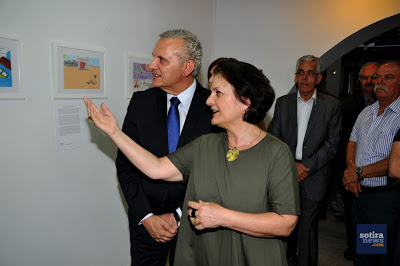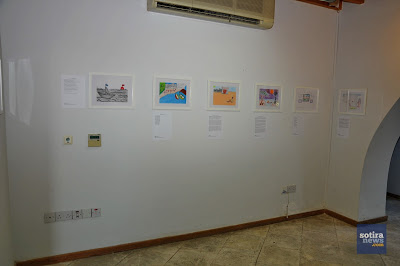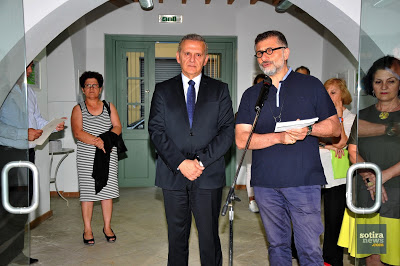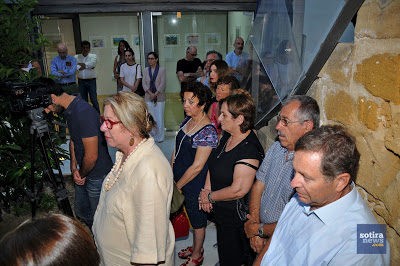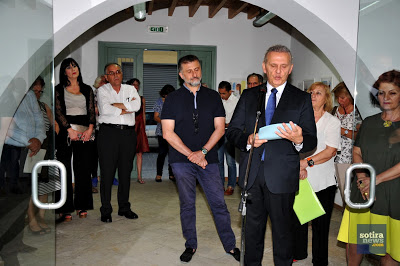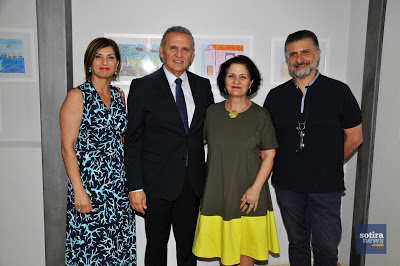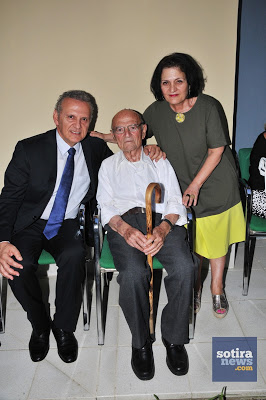A special exhibition with exhibits, narratives and testimonies of students of Rizokarpasos and Deryneia / Sotira High Schools was presented at the Nicosia Arts Center.
This is the art exhibition entitled "Home and Identity" by the artist Tula Liasi, in which thirty students from the High School of Rizokarpaso and the High School of Peace and Freedom Deryneia / Sotira participated with written stories and works of art.
The students of the schools were asked to analyze and determine the factors that influence their individual ideas about the house and how these factors interact with their identity, ie how the student of the occupied Rizokarpas defines his house on the one hand, and the students on the other. of Deryneia and Savior.
The exhibition was inaugurated by the Commissioner for Humanitarian Affairs and Overseas Affairs, Mr. Fotis Fotiou, who praised both the work of the artist Tula Liasi and the work done by the students of the two schools.
The exhibition will remain open until June 17.
The greeting of the Commissioner of the Presidency, Mr. Fotis Fotiou:
It is with great pleasure and satisfaction that I responded to the invitation to speak at the presentation of the new work of Tula Liasi. Joy because the author is a person with a special offer and love for her place, and satisfaction because another work, with the exhibits and the stories and testimonies of students, adds important information about our ancestry and roots, but also about what young people really think about the occupation, the refugees and other consequences of the Turkish invasion.
But first I would like to refer to the identity and life of the author herself. She was born in Agia Triada, Aigialousa, in 1957, where she lived until she was eighteen. In 1975, after being trapped for a year, she left to study first in Athens and later in the Netherlands. There she completed her studies in the visual arts.
Abroad, she was still passionately fighting for her country and anxious for her parents. Savvas and Maroula Liasi, two emblematic figures among our captives. Twenty whole years passed before she was finally allowed to return to her village. At first for a few hours, later for a few days and since 2003, after the roadblocks were opened, for three months, as a simple visitor more than as a resident.
We said goodbye to Maroula Savva Liasi on April 21 last year. Her funeral was held in the church of her village and she was buried in the cemetery of Agia Triada, next to the grave where on July 12, 2014 the remains of her missing son and brother of Tula, Giannaki were placed. In a tomb that with unique reverence and love was prepared by the father of Savva Liasi who is a living hero of Cyprus, a man who considers Karpasia his paradise and refuge.
Recently, I had the honor of receiving him in my office, and during our meeting he handed me a respectable sum to be allocated for the needs of the Commission of Inquiry into the Missing. His child has been missing for 40 years. And the wounds in his soul from the pain and agony of so many years can not be healed by anything. But he had the courtesy and kindness to act as he acted as a personal support to the efforts to investigate the fate of each missing child, father, husband and brother.
We hope that with him this will happen as soon as possible because most of the cases of our missing are still unexplored. And, unfortunately, the life cycle of more and more relatives who leave without getting any answer for their loved ones is coming to an end.
The story of the Liasi family from the Holy Trinity of Aigialousa is one of the most characteristic, in terms of the drama that Cyprus lived and continues to live as a result of the betrayal and destruction of 1974.
Having these origins, and living since 1980 in the Netherlands where her way of life and experiences made her feel more strongly the contrasts between her two worlds, Tula Liasi created in the last decade two series of works, which she dedicated to her fellow villagers. in order to honor their difficult lives.
The Achaean Coast (2004) and the Rusty Testimonies (2013). In these works he tries to record not only the loneliness, the silent resistance and the hope of the mostly very old trapped, but he tries, with the power of art, to depict the deterioration of the quality of life in the occupied ones during the last forty-two years. .
And we come to her new work entitled "Home and Identity", which is a special art exhibition with works by students of Rizokarpasos High School and the High School of Peace and Freedom in Deryneia.
"Home and Identity" is the context in which Tula Liasi, as an artist and art teacher, bases her research: a work that seeks to provide answers to how these issues can be integrated into art education in conflict areas, where the home and identity are constantly changing, redefining and negotiating.
The research focuses on the two schools I mentioned above. Thirty students participated in the program: with written narratives and works of art, which were then analyzed to determine the factors that influence students' individual ideas about home and how they interact with their identity.
I think it is very interesting to see on which axis of thought Tula Liasi based her research:
Home is a powerful word - a word that is central to our lives. But what is its significance? Is the house a place? Is it a geographical location? Is it an architectural edifice? Is it a city or a village, a building or a garden? Is home a place where we live? Is it an emotion associated with a particular place? Or does the home consist of the people - friends and family - around us? Is it natural or imaginary, conceptual, psychological? Is the home part of who we are, of our identity?
These questions of Toula Liasi certainly have their special importance and demonstrate the depth of thought and reflection with which he deals. But it still goes on:
How does the home relate to educational theories and practices and especially to art education, which has its own creative and expressive language? Do home and identity, as mentioned in art education, acquire an additional dimension in conflict areas?
From all this one can conclude how much value Tula Liasi's house, her house and the place of all of us are. So, it is not at all strange, in fact, that she used her professional platform to contribute positively to not forgetting her home and the place of all of us and to make use of the thoughts of the children themselves regarding the house and the factors that affect, or not, their identity.
It is clear that the project also has a strong learning goal: to help students develop an awareness of identity by dealing with their ideas and feelings about home.
As Tula Liasi believes, awareness of our roots and origins can illuminate and facilitate our future course. In fact, in conflict areas, this is particularly important because instability and uncertainty can favor identity crisis.
However, the result of the whole work of Tula Liasi is very encouraging. It proves, first of all, that the new generation is indeed inextricably linked to its roots. And that our young people have both thought and mind and vision. And values that are not open to red lines and borders. They have a free spirit and are strongly occupied by the desire to overthrow the situation brought about by the illegal invasion and occupation of a large part of our homeland.
The children of the occupied school see their home in Karpasia as a shelter and a place of warmth and security, located in a beautiful, but oppressed by the conquering environment. The children of the free school, which is adjacent to occupied Famagusta, consider as their home more the one that is lost and determined by "refugee stories" and to which they long to return. Even if not all come from refugee families.
Thus, the work of Tula Liasi has the weight of the indisputable testimony of the children, who tomorrow, growing up and completing their education, will be the ones who will decide for the fate of their place, that apart from everything else important and non-negotiable together with Termination of the occupation is the guarantee and implementation of the human rights and freedoms of all Cypriots. Among them are the freedoms of movement and establishment and the right of everyone to their property. Without these freedoms and rights, the notions of identity and home will disappear fatally.
Congratulations to Tula Liasi, congratulations to all our teachers for cultivating in our students values that continue and preserve our roots, traditions and culture.
True how great truths the lyrics of Kostis Palamas testify:
"The house where I was born, even if it is trampled on by foreigners, is also inviting me;
Thank you and I wish you all the best in Tula and all of you.
SotiraNews / Photos: Lefteris Kolokotronis
